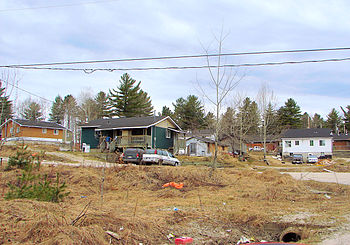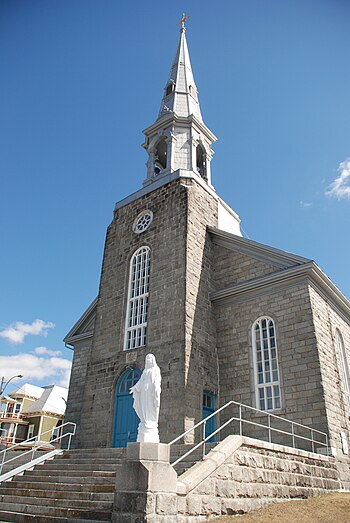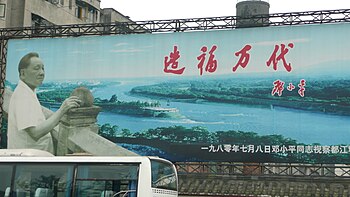 |
| Highway 117 at Reservoir Dozois and the Ottawa River, Quebec, built in Algonquin lands(Photo credit: Wikipedia) |
 |
| Rapid Lake reserve of the Barrière Lake Algonquins, Quebec, Canada (Photo credit: Wikipedia) |
 |
| Rapid Lake reserve of the Barrière Lake Algonquins, Quebec, Canada (Photo credit: Wikipedia) |
 |
| Rapid Lake reserve of the Barrière Lake Algonquins, Quebec, Canada (Photo credit: Wikipedia) |
A friend of mine this week produced unexpectedly the
script of a talk I gave in Ottawa in 2008 about the perilous life lived over
the centuries by the Algonquin people of Barriere Lake, situated in the La
Verendrye Wildlife Reserve, in Quebec several hundred miles north of Ottawa.
The talk dealt with the history of
these particular lands which were occupied by the Algonquins when Europeans
first came to Canada, and are still so occupied. But what happened to these
people, or should I say what has been done to these people, how they have been treated
by Euro-Canadian legislatures, businessmen and officials, constitutes a
history lesson that I would venture to say hardly any Canadians have ever
learned in their schools.
First, I decided to leave aside the
inherent rights of indigenous people, stemming from before Europeans came among
them, rights that have been recognized by the Supreme Court, have been included
as inalienable rights in the Charter of Rights and Freedoms, although largely
denied by society at large. So my talk dealt with only those rights that indigenous
people have secured under the white man’s law that has governed them ever since
colonial Canada was founded.
In 1763 the Royal Proclamation winding
up the years of war between England and France provided that no lands should be
settled without the agreement of the Indian tribes who occupied them, that
agreement to be given at some sort of public assembly. In fulfilment of this
undertaking, between 1870 and 1921, what are called the Numbered Treaties were
signed across the country, from Ontario to Alberta, under which the native
people undertook to cede and surrender all their rights to the land, in return for provisions written
into each of the treaties. These were, of course, woefully
unequal negotiations, to such an extent that one could be forgiven for calling
them fraudulent; but they form the basis of much Indian politics as it exists
to the present day.
However, this provision did not apply
to the vast territories ceded in the seventeenth century by the Sovereign to
the Hudson’s Bay Company, in which Barriere Lake rests, but these lands were
sold to the federal government by the company in 1870, and so became subject to
the Royal Proclamation. In 1912, the
lands in what is now Quebec province were transferred from the federal government
to the province of Quebec, which undertook to obtain surrender of Indian rights
in the same way as Canada had done in the past. Somehow or other, this law was
never applied in Quebec, or in most of British Columbia, for that matter,
another part of the country in which treaties were, for the most part, never
signed.
Of course, the lower Ottawa Valley
--- including the city of Ottawa --- was occupied by loggers and other
businessmen without the legally necessary consent being obtained. The Algonquins
who had lived in these lands from time immemorial repeatedly petitioned to have
their rights respected, but eventually so many of them were moved away that
those who remained were treated by the law as squatters on their own lands. (I invite my readers, as I invited my audience, to reflect here on the monstrous
arrogance and injustice of this.)
Many of those who were moved away from
their traditional lands --- I believe most of them came from the Ontario side
of the river --- were gathered by priests at Oka, Quebec; and in 1851 at the
urging of the Roman Catholic Church, a large reserve was established at
Maniwaki by the federal government , where all Algonquins were supposed to be
gathered --- safely out of the way of loggers and others wanting to use their
lands; and easy of access for the priests.
The Algonquins of the northern Ottawa
valley in Quebec --- the Ottawa is a long, meandering river across the
middle-northern part of Quebec, finally
coming down in a wide sweep to form the boundary between the two provinces,
before flowing into the St Lawrence at Montreal --- the Alqonquins from
northern Quebec never did move to Maniwaki. These included the people of
Barriere Lake, and other settlements that remained independently living their traditional way of
life were those of Grand Lake Victoria and Lake Simon, hidden away almost until
the present day, in the vast Quebec wilderness.
Barriere Lake got that name
because the waters of the Gatineau and
Ottawa rivers would, at a certain time of the year, cross a natural stone barrier,
and run into each other. Fish would spawn and feed in the shallows around the
stone weir, which became a central place for the Algonquins --- so they have
always called themselves the People of the Stone Weir.
(I might mention here – I didn’t in
my original talk --- that the Algonquins have played an important role in
Canadian history, not surprising when one considers they lived astride the
great Ottawa river, and controlled access for the first whites who penetrated Canada
in the sixteenth century. When Champlain, fresh from founding the new town of Quebec
in 1608, noticed that it was the Hurons, from what is now northern Ontario,
that were bringing in all the furs, he decided he had to reach them, so as to
establish himself and his community as first buyers. For some years his access
was stopped by the Algonquins, who were part of the Hurons’ immense network of
trading contacts across eastern North America. That is another story, one also
probably unknown to most Canadians, but it has been the subject of one of the
greatest works of history written by a Canadian, Bruce Trigger’s Children of Ataaentsic whose subtitle is
A History of the Hurons until 1660).
In 1871, without any warning, the
land occupied by the Barriere Lake people was flooded behind a large dam, whose
purpose was to store water so that logs could be floated down the Gatineau, to
Ottawa. So, the fish, animals and people had to move elsewhere. None of the
legally required consent was obtained, no meeting or assembly was held, nothing
like that: the Algonquins were simply treated as if they weren’t there.
At first the northern Algonquins were
able to survive, because the logging techniques used in those days were simple,
and the loggers did not build roads or settlements. But by the 1890s, the whole
of the Algonquins’ traditional forest was subject to timber leases, given away
by the provincial government for $8 a square mile. Naturally, no consent or consultation
delayed the deal --- again, in fact, a veritable steal for the companies.
From 1928 for the next five decades,
Quebec province passed more than 100
orders-in-council governing the Barriere Lake traditional lands. In that year
the Grand Lake Victoria Indian game reserve of 6,300 square miles was
established. This is the closest that Canadian law ever came to recognizing the
rights of the Algonquins in and to their traditional lands, It did recognize
that Indians had previously been exclusive occupants of these lands and gave
them exclusive hunting rights.
So what happened to this Indian game
reserve? Well, a year later, 1929, Gatineau Paper, a subsidiary of Canadian International
Paper, built the Cabonga dam to create a reservoir in the very heart of the
Barriere Lake lands. No consent was obtained; no compensation for flooded lands
was paid; the Algonquins were never even told how much land was to be flooded
or that the reservoir would have a fluctuating shoreline --- a matter of
essential importance to the Algonquin way of life. The company paid 13 or 14
people $30 each to enable them to build small cabins --- a total of $525 in
compensation. Another really good deal. Nobody could say the law wasn’t
generous --- to the companies.
The province made no effort to
enforce the exclusive indigenous hunting provisions of 1928 ; in fact in 1936
they revoked them. Three years later the province built a major road right
through the hunting reserve --- again without consultation --- and declared 10
miles on each side of the road to be a reserve forbidden to all hunters,
specifically ending the indigenous “privileges,” as they called them.
In 1948 what was left of the 1928
hunting reserve was renamed a beaver reserve, in which the Algonquins now had
an exclusive right only to trap beaver.
In 1945, 1950 and 1955, the highway
reserve that had been carved out around the road was gradually increased in
size and re-named LaVerendrye Wildlife Reserve, in which all hunting was
forbidden.
As a result of this a running Algonquin battle began
with game wardens. But again, preferential treatment was given to outside
hunters; a large tourist establishment was built by Euro-Canadians that was
given exclusive hunting rights in the area in which hunting was otherwise
forbidden.
In 1965, the Wildlife Reserve was
opened for one year to a moose hunt. That has been renewed every year since
then. At first, Indians were given some priority as guides, but this was
removed in 1980. Henceforth white sports hunters have taken more moose than the
Algonquins whose whole way of life depended on the moose. (This was true at
least in 2008, and I would be surprised if it is still not true.)
(It is worth observing in parenthesis
that the designation of the reserve as being for wildlife protection was surely
either the most farcical joke ever attempted in Canadian nomenclature, or a
cruel and pitiless measure designed to humiliate the traditional occupants of
the land. The department of natural resources was given control over the
wildlife. But another department, concerned with industry was in charge of the
forest. Such confusion gives an idea of the inchoate incompetence of the
provincial government.)
In 1993 I wrote in my book People of Terra Nullius (p 116): “For
more than 40 years, from at least 1919, the Quebec government repeatedly
refused to confirm the Algonquin ownership of their land, arguing that it was
under timber licence and within a game and fish reserve. In contrast land
grants were given to the Hudson’s Bay Company and the Church as soon as they
asked.” (This is a common theme of Canadian history: e.g. in the area of Banff
national park, established in the traditional lands of the Stoneys, the Stoneys
were booted out, while a German mining company was given immediate priority over
the Indian interest. In fact, the Stoneys were confined to a small reserve in
which they could not make a living, and had to be reluctantly supported by the
government, so reluctantly that the Stoneys found themselves wanted neither in
the reserve nor out of the reserve, where they were a nuisance in the way of
tourist and other development. And, closer to home, in James Bay, the people
who originally lived where the town of Chibougamau now stands had to move
around at least 10 times to make way for industrial developments of some kind or
other.)
“Finally, in the late 1950s, at the
urging of the Church, Quebec offered the Algonquins the use (but not the
ownership) of 59 acres of sand on the shores of the Cabonga reservoir. The
people themselves were not consulted. The reserve was established by an
order-in-council of September 7, 1961, it referred to the Algonquins as les sauvages, a term that has long since
lost its benign meaning, even in French. This is not remote history, the man
who signed the order-in-council was Jean-Jacques Bertrand, who was premier of
Quebec just before the first term of Robert Bourassa.”
The Parti Quebecois government
carried on this noble record of ignoring the Indian interest. Thanks to the
PQ’s efforts, today (2008) Barriere Lake lands are subject to administration by
at least four government ministries (each ministry has two regional offices
with something to say), two forest management units, a Crown corporation SEPAQ set up to manage recreational activities
within wildlife reserves, with a requirement to make money. I know that fifteen
years ago none of these took any account of the aboriginal interest.
But I believe a proposed new Quebec
Forestry Act will set up regional committees in which aboriginal communities
are supposed to take part. (This is presumably the initiative which, when
challenged by the Grand Council of the Crees, was declared to be
unconstitutional because it ignored the aboriginal interest. As a result a
judge ordered Quebec to suspend forestry operations for six months while they
wrote a new law. .The Quebec government appealed for a new judge, so the old
one was dismissed and the new one turned
out to be more amenable to the government’s
interests, and Quebec won the case. Wow!)
So far as I know land planning in the
region does not even mention the Algonquin interest. And this is a region in
which they are almost the only permanent population.
I better stop it there. I imagine
that no one here has learned any of this history when going through the
education system. But perhaps this outline may give you some idea of how the
Barriere Lake reserve --- which, of course, does not appear on any map of
Canada that I have ever seen --- became one of the poorest communities in
Canada.
When I first visited the reserve late
in 1980, some four million dollars of support payments of one kind or another
were coming into the reserve, but there was no shop, not even a taxi, not a
single business, so all that money went straight out to be spent in Maniwaki. This
is almost the definition of a colonialist situation. Right here, within a few
miles of
the nation’s capital.
Long before I gave that talk, of course, in 1991, the
people of Barriere Lake signed what has become known as the trilateral
agreement, with Quebec and federal governments, designed to take account of the
indigenous interest in their own forest, that has continued to be clear-cut around
their ears ever since. The agreement was hailed by several noteworthy observers
as a landmark in government-indigenous relations, that could lead to more
similar agreements across the country. But here we are in 2015, and still one
or other of the governments is resisting having to implement this agreement. The
governments have taken advantage of a split within the community by suspending
the band council, elected by traditional methods, naming an alternative band
council that had to make its seat of government outside the community, imposing
Third Party Management on the reserve, and using various other of the tricks
that governments have always used to avoid taking honest responsibility for the
affairs of the Indians whose care is assigned to them under the constitution.
Although I do not have chapter and verse for each move
in this tragic drama, I know that still, 35 years after all this began:
*the
housing crisis in the community has reached tragic proportions
*The Quebec
government continues to use its police forces to impose its will on the people
of Barriere Lake.
*Children
have been prevented from speaking Algonquin in school by teachers hired by
Third Party Management --- a grim throwback to the era of residential schools.
And so the grim and tragic dance continues.



